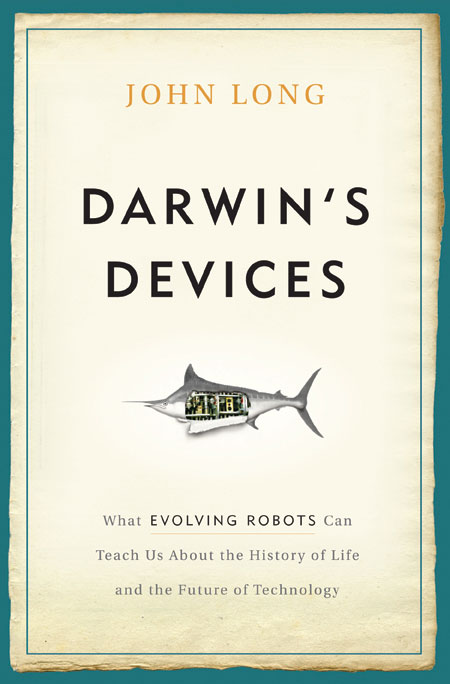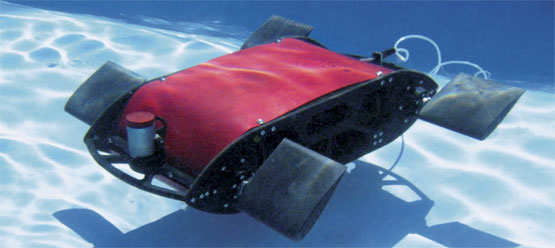If Darwin Designed Robots
The research of biology professor John Long bridges two seemingly disparate worlds: evolutionary biology and high-tech robotics. In this excerpt from his new book, Darwin’s Devices, he explains how studying the evolution of ancient fish can shed light on the technology of tomorrow.

I am a biologist, and I study robots. But as soon as I started describing my research to other people, it was clear I was in trouble. I was speaking to a longtime friend and colleague about a biology grant I’d just gotten from the National Science Foundation to build robots, when he stopped me in my tracks. “What do robots have to do with biology?” he asked. I knew then, with the certainty that only dread can provide, that this was an inescapable question—it was the issue that would come up first from now on, every time one of my students or I presented our strange new work to biologists.
What’s the problem? First and foremost, biologists do not study robots, or at least they’re not supposed to. They work on organisms—living things, their environments, and their evolutionary history. They use machines as tools to ascend a rainforest canopy, as instruments to measure biomechanical properties, as modes of transportation to collect fish from a coral reef. As my friend stated so succinctly, machines in general, and robots in particular, have nothing to do with biology directly—from his point of view. Not from mine.
You see, for all my work with robots, I love real fish. More than 20 years’ work has shown me much about their shape and structure, how they move, and how they evolved. But real fish only reveal some of their secrets. As with any science, we are limited by what we can and cannot observe and measure.
Like a clumsy criminal, evolutionary adaptation leaves behind many clues in the DNA and anatomy of extinct and living species. But adaptation never leaves behind witnesses or a surveillance tape. Biologists inevitably have to guess at the process of evolution, and the best guesses about what went on come from reconstructing the events. Using the clues—the physical evidence—good investigators can piece together a step-by-step sequence of places, agents, and interactions that most likely caused the outcome.
What can we do to test this sequence? We can build models, let them run, and see if their behavior matches our predictions based on our evolutionary reconstruction. We can also do one better: let the models evolve. And what are those models? Robots.
Robots—mobile ones, anyway—are essentially self-propelled computers. They are machines that run sets of instructions—their software—and produce an output. Autonomous robots take things one step further. They use their own sensory inputs to perceive the world, make decisions about how to move in that world, and, in turn, have those movements affect how they subsequently and continuously perceive the world. This constant feedback between what an agent perceives and how it moves is what my colleague Ken Livingston [Vassar professor of psychology] and I call a perception-action feedback loop. Multiple such loops can operate in parallel, working in combination, fusion, or competition. What we observe the agent doing—moving and interacting with its immediate environment—is what we define as behavior. This behavior is something that autonomous robots have that computers do not.
Autonomous agency is, ultimately, the answer to the question, what do robots have to do with biology? They enable us to build models of how organisms behave. This synthetic approach underlies what [researchers] Rolf Pfeifer and Christian Scheier call embodied cognitive science or embodied artificial intelligence, and it is at the core of the defense of robots I offered earlier: build embodied robots that behave as biologically inspired autonomous agents. The behavior that these agents create can then be understood on the basis of their physical design, programming, and interaction with the physical world. In other words, if we can build it, then we can understand it.

And when it comes to understanding real fish, we fish-frenzied scientists are after what biologist Frank Fish (yes, that’s really his name) of West Chester University says are the biological secrets of swimming fish: stealth, maneuverability, and efficiency. By these measures, fish beat any engineered underwater vehicle. But we don’t know how.
Life is challenging to understand. My non-scientist father, knowing that I did something called “biomechanics” with fish, asked me, “So what are you studying, biomechanically, about fish?” Sensing a sincere reach across the aisle, I began, “Well, dad, I try to understand how they swim.” He paused for dramatic effect, and then responded, brightly, “Well that’s easy. They wiggle their tails back and forth!”
He was absolutely right, at least about the wiggly part. But beyond the simple tail wiggling, how fish swim—accelerate, migrate, turn, leap, and burrow—is an open scientific question.
Here’s where the robots help us out: when we build a fish-like robot and it’s not stealthy or maneuverable or efficient, our failure teaches us what we don’t know. But judging from the feeding frenzy of research activity, we are understanding more. Robotic fish are being built and tested in the U.S. at places like Harvard University, University of Washington, and Michigan State University; in Europe, at laboratories at University of Bath, Tallinn University of Technology, and University of Graf; in Asia, at labs in China, Korea, and Japan.
What do we know? For starters, we know what fish have to put to work: physics. For a fish to swim it has to transfer momentum from its body to the surrounding fluid. The wiggles that create the body’s momentum are made by muscles, non-linear and non-reversible micromotors in series and parallel that generate a load, thanks to Newton’s Third Law, in proportion to the load created by the body’s skeleton and by the body’s resistance to its own wiggles in the water. Internal forces are coupled dynamically to external forces. Should you take this on mathematically, you’ve got to couple the non-linear internal dynamics with the Navier-Stokes world of the water.
Robots do this physics for free. When students in my lab build a flexible tail and attach it to a reciprocating motor, the tail generates thrust the moment you put it in the water. Nobody had to solve Navier-Stokes equations to get that to happen. We let robots do the work for us.
Our robotic fish, which we call Tadros (short for “tadpole robot”), flap a tail that bears as its main skeleton a biomimetic backbone, a structure we know in ourselves as a vertebral column. The backbone is an ancient structure, having evolved 500 million years ago in our fish-like ancestors without, ironically, any bones. This boneless backbone is called a notochord. Our biomechanical studies have shown that when you add bones, called vertebrae, to a notochord it gets stiffer. Knowing that, we vary the stiffness of the biomimetic backbones in the robots to test ideas about how fish swim. The punchline: body stiffness determines swimming performance, with stiffer backbones allowing the robot to swim faster.
Knowing that body stiffness is key to swimming performance, we’ve been evolving robotic fish. With our biological hats on, we are keen to understand what evolutionary pressures drove the evolution of the first fish-like vertebrates some 500 million years ago. Since the main skeleton of fish was and is the backbone, we allow the stiffness of the backbone to vary in a population of robotic fish. We test individuals in a generation on their ability to find food and to avoid predators. Winners get to mate (no worries, that part is done on the computer).
What we see is that both speed and acceleration improve as body stiffness increases. But there’s a trade-off: at a stiffness, maneuverability drops. That’s evolution—the next generation looks different than the previous, and sometimes, evolution is a compromise.
By evolving Tadros, we’ve embarked on a journey of considerable discovery, one that helps us understand not just what a backbone does for fish, but what evolution can do for technology, and what technology can do for our knowledge of the history of life.
Adapted from Darwin’s Devices: What Evolving Robots Teach Us About the History of Life and the Future of Technology (Basic Books, 2012), by John Long.
